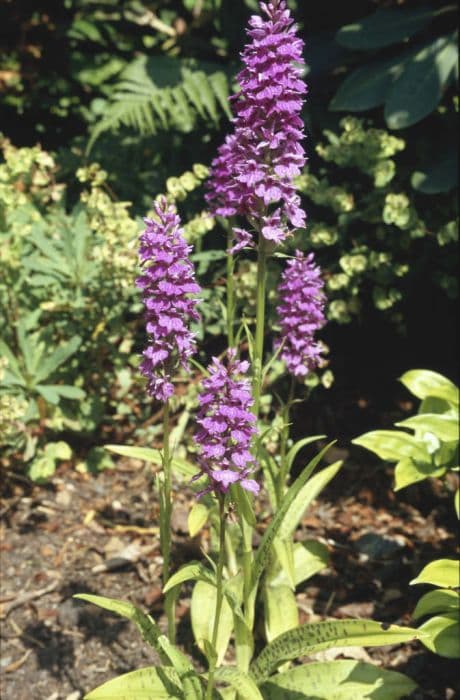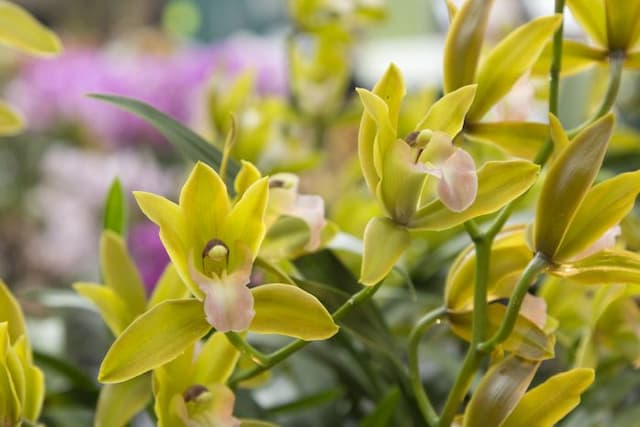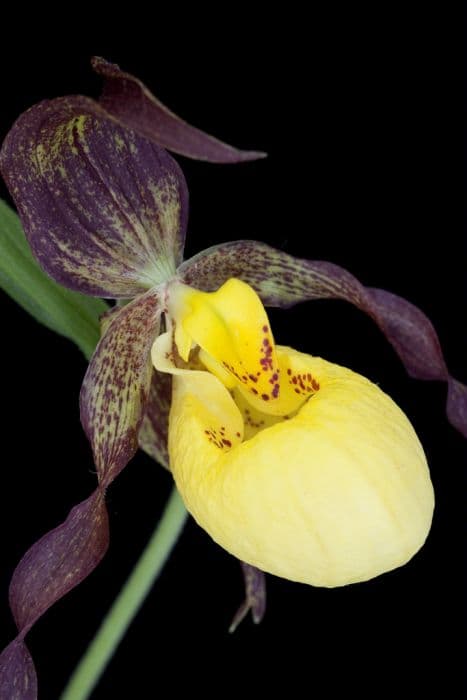Madeiran Orchid Dactylorhiza foliosa

ABOUT
The plant known as the Madeira orchid is a striking perennial that boasts a lush, green appearance with distinctive floral characteristics. The foliage consists of broad leaves that are lance-shaped, forming a rosette at the base of the stem. These leaves have a rich green hue, often with spots or markings that add to the visual interest of the plant. The most captivating feature of the Madeira orchid is its floral spike, which comprises numerous individual flowers. These blossoms are typically purple or pink in color, sometimes displaying intricate patterns with darker spots or striations. The flowers are shaped like little helmets due to the fusion of some petals and sepals, with a prominent lip that is three-lobed, often serving as a landing platform for pollinators. Each flower exhibits a delicate beauty, with a structure that is both complex and symmetrical. The blooms are arranged densely along the spike, creating an eye-catching display that can add a touch of elegance to any setting in which the orchid is found. The Madeira orchid is not only appreciated for its ornamental qualities but also for its robust nature, which allows it to thrive under the right conditions. While the individual elements like leaves and flowers contribute to its overall beauty, it is the harmonious combination of these features that truly encapsulates the allure of this exceptional plant.
About this plant
 Names
NamesFamily
Orchidaceae
Synonyms
Madeiran Orchid, Dense-Flowered Orchid
Common names
Orchis foliosa, Dactylorhiza foliosa subsp. foliosa.
 Toxicity
ToxicityTo humans
Madeira orchid, generally known as Dactylorhiza foliosa, does not have a well-documented profile of toxicity to humans. There is limited information available on the ingestion of this orchid species, and orchids are not commonly known for being toxic to humans. Typically, most orchid species are considered non-toxic, and the Madeira orchid is not commonly associated with human poisoning. However, as with any plant not intended for consumption, if ingested in large quantities it might cause gastrointestinal discomfort, including symptoms such as nausea, vomiting, or diarrhea.
To pets
Madeira orchid, also referred to as Dactylorhiza foliosa, does not have a notable toxicity profile for pets such as dogs and cats. Orchids, in general, are usually considered safe for pets, and there is no widespread documentation of toxicity related to the ingestion of the Madeira orchid by pets. If a pet were to ingest a part of this plant, it is unlikely to cause more than mild digestive upset, if any symptoms at all. However, it is always recommended to monitor your pet for any signs of illness and to consult a veterinarian if any adverse reaction is observed.
 Characteristics
CharacteristicsLife cycle
Perennials
Foliage type
Deciduous
Color of leaves
Green
Flower color
Pink
Height
1-2 feet (30-60 cm)
Spread
1 foot (30 cm)
Plant type
Herb
Hardiness zones
7
Native area
Madeira
Benefits
 General Benefits
General Benefits- Ecosystem support: Dactylorhiza foliosa, commonly known as the Madeira Orchid, provides nectar and pollen for a variety of insects, contributing to biodiversity and the sustaining of local ecosystems.
- Aesthetic value: With its striking flowers, the Madeira Orchid is valued for its ornamental beauty, enhancing the visual appeal of natural landscapes and gardens.
- Soil stabilization: The root systems of the Madeira Orchid can help stabilize soil in its native habitat, preventing erosion and promoting soil health.
- Research and education: As part of the orchid family, Dactylorhiza foliosa serves as a subject of study for botanists and horticulturists, contributing to our understanding of plant biology and ecology.
- Cultural significance: In its native regions, the Madeira Orchid may hold cultural importance and can be utilized in local customs, art, and folklore.
- Conservation indicator: The presence of Dactylorhiza foliosa in the wild can indicate a healthy environment, and its conservation status can serve as a barometer for the well-being of its ecosystem.
- Ecotourism attraction: The Madeira Orchid's unique and attractive appearance can draw visitors interested in flora, thus supporting ecotourism industries.
 Medical Properties
Medical PropertiesThis plant is not used for medical purposes.
 Air-purifying Qualities
Air-purifying QualitiesThis plant is not specifically known for air purifying qualities.
 Other Uses
Other Uses- Dye production: The roots of the Madeira orchid have historically been used to create a rich dye for fabrics.
- Perfumery: Some species of Dactylorhiza are noted for their fragrance and can be used to create natural essences for perfumes.
- Educational specimens: These orchids can be utilized in educational settings to demonstrate diverse plant morphologies and reproductive strategies.
- Photography subject: Due to their beauty, Madeira orchids are often the subject of botanical photography and art, showcasing the diversity of plant forms.
- Ecosystem indicators: As they require specific conditions to grow, monitoring their presence helps in assessing the health of their native ecosystems.
- Culinary decoration: The flowers can be used aesthetically to garnish dishes, although they are not typically consumed.
- Floral arrangements: Their striking appearance makes them a popular choice for inclusion in ornamental bouquets and floral displays.
- Biological pest control: They can form part of a habitat to support insect predators that keep pest populations in check.
- Butterfly attractants: The Madeira orchid's flowers can attract and support populations of local butterfly species, aiding in pollination.
- Cultural symbols: In some cultures, they might be used in ceremonial practices or as symbols in storytelling and folklore.
Interesting Facts
 Feng Shui
Feng ShuiThe Madeira orchid is not used in Feng Shui practice.
 Zodiac Sign Compitability
Zodiac Sign CompitabilityThe Madeira orchid is not used in astrology practice.
 Plant Symbolism
Plant Symbolism- Rarity: The Madeira Orchid is not a common plant and can symbolize the uniqueness or rare beauty in a person or situation.
- Delicate Strength: Orchids are known for their delicate appearance, yet are resilient and strong, which can symbolize an individual's ability to endure tough conditions with grace.
- Elegance and Sophistication: The Madeira Orchid, like many orchids, is often associated with elegance and sophistication, making it a symbol of refined beauty.
- Femininity: Many cultures associate orchids with femininity, fertility, and charm, reflecting the gentleness and allure often attributed to women.
- Luxury and Opulence: Given how orchids are often prized and coveted, they can symbolize a sense of luxury and wealth.
 Water
WaterFor the Madeira orchid, it's crucial to keep the soil consistently moist but not waterlogged. Watering should be frequent, generally every 5 to 7 days, depending on climatic conditions and the plant's environment. A good method is to pour water gently around the base of the plant until it starts draining from the bottom of the pot, indicating the soil is thoroughly moistened. The amount of water will vary with pot size, but a rough guideline is to use around 8-16 ounces of water weekly. Be careful not to let the plant sit in water, as this can lead to root rot.
 Light
LightThe Madeira orchid thrives in bright, indirect sunlight. It is best positioned in a spot where it can receive filtered sunlight throughout the day, such as behind a sheer curtain near a sunny window. Direct sunlight, particularly during the hotter parts of the day, should be avoided as it can scorch the leaves and stress the plant.
 Temperature
TemperatureThe Madeira orchid prefers moderate temperatures ranging between 50 to 70 degrees Fahrenheit. It can handle a minimum temperature down to about 40 degrees Fahrenheit and a maximum temperature up to about 80 degrees Fahrenheit. For ideal growth, maintaining the temperature around the middle of this range is advisable.
 Pruning
PruningPruning the Madeira orchid isn't typically necessary for the health of the plant, but you can remove dead or yellowed leaves to maintain its appearance. The best time for pruning is after it has finished flowering, usually in the summer. Snip off spent flower stems close to the base to encourage new growth.
 Cleaning
CleaningAs needed
 Soil
SoilThe Madeira orchid thrives in a soil mix that is well-draining with plenty of organic material, such as a combination of fine bark, perlite, and peat. It prefers slightly acidic to neutral soil with a pH ranging from 6.0 to 7.0.
 Repotting
RepottingThe Madeira orchid should be repotted every one to two years in fresh soil mix to maintain health and vigor.
 Humidity & Misting
Humidity & MistingThe Madeira orchid prefers high humidity levels, ideally between 60% to 80%, to mimic its native humid environments.
 Suitable locations
Suitable locationsIndoor
Use a well-draining mix and ensure high humidity.
Outdoor
Plant in dappled shade with moist, rich soil.
Hardiness zone
7-9 USDA
 Life cycle
Life cycleDactylorhiza foliosa, commonly known as the Madeira Orchid, begins its life as a seed dispersed into suitable habitats, usually containing fungal partners essential for germination. Upon successful symbiosis with the mycorrhizal fungi, the seed germinates and grows into a protocorm – an underground tuber-like structure – which develops into a small orchid plant with leaves. In the subsequent years, the plant increases in size and biomass through vegetative growth. Once mature, the Madeira Orchid produces striking flowering spikes adorned with numerous purple-pink flowers, primarily during late spring to early summer. After pollination, possibly facilitated by insects, it sets seed pods that eventually release tiny seeds into the air to disperse and begin the cycle anew. Lastly, the plant enters a dormant phase during unfavorable seasons, where it survives underground as a tuber until conditions for growth return.
 Propogation
PropogationPropogation time
Spring to Summer
Propogation: For the Madeira orchid, which is known scientifically as Dactylorhiza foliosa, the most popular method of propagation is by division. This process is most effectively carried out in the late summer or early fall, after the plant has finished flowering and enters its dormancy period. To propagate by division, carefully lift the entire plant from the ground and gently separate the pseudobulbs, making sure each division contains at least one pseudobulb and a portion of the root system. Replant the divisions promptly, maintaining appropriate spacing to accommodate future growth. It's critical to keep the newly planted divisions evenly moist and to provide them with a light, but not direct, sun exposure until they become established.









